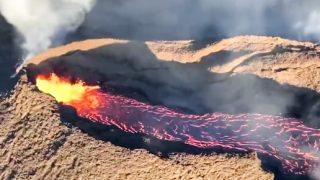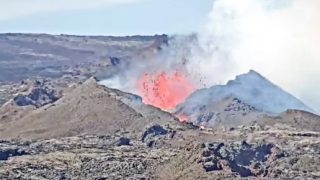One side-effect of the Mauna Loa Eruption we almost forgot about struck silently this week. That’s vog. It was a huge problem in Hawaii, but not for years, so we somehow thought it was behind us. Yesterday’s episode proved that to be the wrong conclusion.
Mauna Loa vog traveled as far away as Kauai this week.
Vog did get in our eyes last night and irritated us. This week’s air has been heavy with winds from the south, bringing the Big Island’s vog throughout the Hawaiian Islands chain, even as far as 250 miles away from Mauna Loa. We’re excited about today’s expected return of Hawaii trade wind conditions after a prolonged absence. That will help push the vog away from us.
See the live Mauna Loa eruption.
Hawaii’s smog, or “vog.” What is it?
It is a unique type of air pollution caused by a mix of sulfur dioxide and other gases from the Big Island’s volcanos, in this case, Mauna Loa.
VOG peaked in 2008 and has subsided to very little, with occasional outbursts since then. But now, there’s the Mauna Loa eruption, vog’s latest source.
At the same time, Hawaii tradewinds are gradually diminishing, which results in more opportunities for vog to sneak up the chain. The University of Hawaii at Manoa scientists have observed a distinct decrease in Hawaii’s trade winds over the past 40 years.
Health and Vog
Vog is detrimental to both animals and plants. The pollutant is acidic and can impair respiratory function. It also irritates the eyes, nose, and throat and can even result in headaches. This is worse for children and others with respiratory issues. The long-term effects of Vog remain unknown.
The University of Hawaii has been researching the health impacts of Vog for the past 20 years. At one point, the Big Island received a failing grade for air pollution from the American Lung Association.
Hawaii’s trade winds.
Trade winds in Hawaii blow most of the time. Our natural weather moderator and air conditioning make Hawaii weather unique and generally excellent.
We think of trade winds as coming from Alaska because they are cool and dry (although they also bring blessed mountain showers). You can hear them rustling in the trees as they blow gently from the north and east. These have been called trade winds for centuries, from when cargo ships depended on them for fast movement. And they are the reason you seldom need air conditioning in Hawaii. Many of us prefer no air conditioning and find A/C unnecessary and expensive.
Kona conditions defined.
We’re not talking coffee here. When we don’t have trade winds, either no winds are present, or they blow from the south. We call these Kona conditions. They can occur anytime, and we sometimes associate them with winter storm conditions.
When the Kilauea volcano began erupting back in 1983, Kona winds started bringing Vog up the island chain. Vog makes visibility poor and causes eye and respiratory irritation big time. Vog feels quite like smog with another name. This week, up the island chain, we’ve seen some of the worst vog in recent years.
Will VOG interfere with your Hawaii vacation?
Probably not, as far as we know, based on the current eruption. We suggest checking the vog Dashboard for updates if you have upper respiratory problems. Air conditioning can help but won’t filter out vog. Setting the unit to “air recirculation” or “closed vent” can prevent outdoor air from entering your vacation rental or hotel room.







very good article..I got very sick from the vog, had to leave the islands early.
and I am here 3-4 times a year, on Maui. I have asthma, it destroyed me
Is more expected??
thanks
ray/lost angeles
Hi Ray.
The vog is supposed to be much less now. Although today on Kauai it was very noticeable and irritating.
Aloha.
I can’t say I’ve noticed any vog here in Hilo since the eruption started — probably a combination of winds blowing it away and the rain that’s been falling nearly every day washing it out of the air. Sorry for the rest of you though.
Not to worry. All you have to do is through billions of dollars into the volcano and it will stop. Also, if everyone did their part in narrowing their own carbon foot print this act would narrow the VOG that is effecting the whole world! Oh and buy an electric car.
Hahaa! That has absolutely little to nothing to do with the vog. Oh btw where do you geniuses think the power for an electric car comes from?? I’ll help you. Fossil fuel!
I lived on the Big Island from 2000 to 2005. Because I lived at the northern tip I was seldom affected by the vog but anytime I travelled the 50 miles south to Kona for shopping I was often so sickened by the vog that those visits had to be very brief. Visitors generally don’t know what it is. They don’t know why the setting Kona sun often dissapears into the vop plume before setting into the ocean. Or why they feel tired, headachey, or generally ill. Or why the visibility is so often so bad in the middle of the Pacific. Many retirees to Kona found it to be so intolerable that they had to relocate. These are not facts which the tourism industry wants to be known so it is seldom publicly acknowledged except when it reaches the other isla
How does vog effect Rainwater Harvesters?
I am in Maui, in Kaanapali… and yes we have vog for 2 days now… headache all day today.. winds are supposed to pick up tomorrow.. fingers crossed
Hi Melika.
Same here. Hope you feel better.
Aloha.
VOG has not been a problem due to the elevation of Mauna Loa…..Live on the Kohala Coast.
Aloha and mahalo for your updates. I would like to point out, however, that here in the Puna District of the Big Island just south of Hilo, we are all clear. We have had no vog, no ash. Other than a glow in the sky from the volcano if the conditions are right, you would not know there is an eruption going on. I feel so fortunate to be able to drive up the saddle and see the eruption! Mahalo again for keeping us up to date on all things Hawaii.
Mahalo for the update from someone in town. We have our retirement house (next year!) in Pahoa, and was wondering if vog was affecting our catchment. In 2018, we were also fine, except for a few days when the trades stopped. Shortly after that, you could taste it in the water, despite multiple filters.
If traveling & you have lung issues, please research VOG. Spouse had asthma. Way back when this happened VOG alerts were very vague. Similar to high surf warnings on the north shore with swells so high.These alerts were VOG alert in south Kona. No instructions on how to take precautions etc. While he was sick in condo most of the time. We kept doors open due to no A/C. He has permanent lung damage due to VOG & horrible quality of life. Drs have warned us twice as to the life limiting results of VOG.
Wife and I have been sneezing a lot with itchy eyes for the past few days, and we are on far Northshore of Kauai, which is as far as you can get from Moana Loa and still be in Hawaii. We have had (and still have) strong trades/off-on rain this week, that seem to be blowing the Vog through the neighborhood.
“When we don’t have trade winds, either no winds are present, or they blow from the south.”
OR – every now and then – we get a storm front that moves from northwest to south east (Kauai to BI) like the one that plowed through this past Thanksgiving and deposited a thick layer of ocean crap on our windows/screens/floors/walls/furniture/etc. But you’re right, we need those winds to keep cool.
While I always look forward to your commentary, your headline for this article is misleading and disappointing. VOG is Not blanketing the entire state. I live here on the slopes of Mauna Loa in the Ka’u district and we haven’t had any vog since the eruption started. The Tradewinds are carrying it over the ocean to Oahu and Maui but with the exception of the northern part of the island, most of the big island is unaffected by vog.
I am at 800 foot elevation overlooking KOA. It really is not much different now that it has been with halemaumau blowing vog for years.
Got in a 4 mile run as per usual.
I would not cancel a trip here because of vog.
This is a fairly normal condition here on the “rock”.
We have been coming to the Big Island since 1983 and for many of those years there was some Vog to deal with, but mostly it just made it seem a tad overcast and the sunsets were affected slightly, but we never experienced any kind of breathing issues, and I have asthma. For people who have never been to the islands, the press and even articles like this one seem geared at scaring people in to staying home. (Follows the “tourists stay away” playbook. For someone who has severe respiratory issues, that might be something for them to consider, but for healthy people, Vog (at least as we have experienced it) is mostly a non-issue.
This is different. Checking Mauna Loa emmission numbers today and you’ll find that they are at 120000 tonnes per day. That is equal to or more than what Kilauea put out when things were really bad for us in Kona in 2008. It is so bad today that friends up on the Hamakua coast woke up at night and called us.